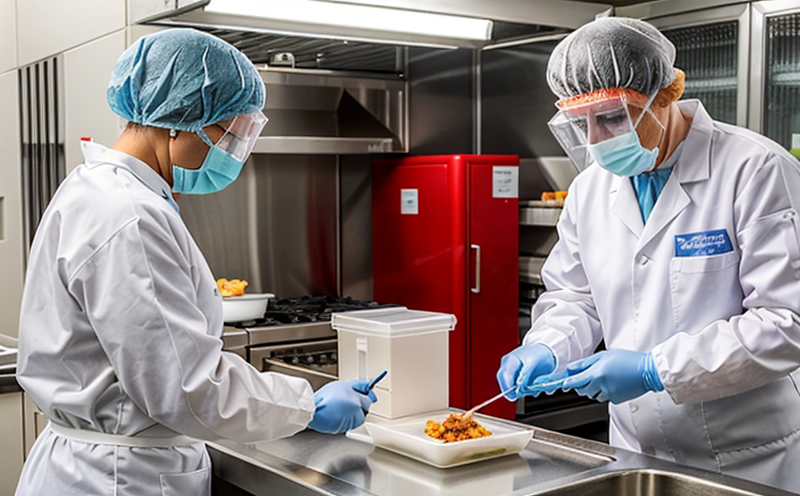ISO 21871 Detection of Vibrio and Viral Pathogens in Seafood
The detection and quantification of Vibrio and viral pathogens in seafood is a critical aspect of ensuring food safety. This service adheres to the requirements outlined in ISO 21871, which provides guidelines for the microbiological examination of shellfish. The primary goal is to protect public health by preventing the spread of infectious diseases caused by these pathogens.
The methodology involves several key steps: sample collection, transport, and preservation; DNA/RNA extraction; quantification using real-time PCR (qPCR); and confirmation through culture-based methods where appropriate. This approach ensures accurate detection levels down to as low as 1 CFU/g, which is essential for maintaining stringent hygiene standards.
Our laboratory employs advanced qPCR technology that allows us to detect even trace amounts of pathogenic DNA or RNA within minutes after sample preparation. This rapid turnaround time enhances our ability to respond promptly to any potential contamination issues. Additionally, we utilize validated media and reagents compliant with ISO 21871 specifications.
The importance of this service cannot be overstated, especially given the increasing prevalence of foodborne illnesses linked to seafood consumption. By adhering strictly to international standards like ISO 21871, our lab guarantees reliable results that meet regulatory expectations and help maintain consumer trust in the safety of seafood products.
Our team consists of experienced microbiologists who specialize in pathogen detection techniques, ensuring accurate interpretations of test outcomes. We provide detailed reports that include not only quantitative data but also qualitative insights into the nature of detected pathogens. This comprehensive approach helps stakeholders make informed decisions regarding product quality and safety.
In summary, our ISO 21871-compliant Vibrio and viral pathogen detection service offers a robust solution for ensuring seafood safety at every stage from farm to fork. It provides peace of mind knowing that stringent controls are in place against harmful microorganisms, thereby contributing significantly towards global health goals.
Our commitment extends beyond just meeting regulatory requirements; we strive to go above and beyond by offering expert advice on best practices for maintaining optimal hygiene throughout the supply chain. This proactive approach ensures not only compliance but also continuous improvement in food safety standards.
Benefits
Detecting Vibrio and viral pathogens early through ISO 21871-compliant methods offers numerous benefits to stakeholders across the seafood industry. For quality managers, it provides a reliable framework for monitoring compliance with international standards, ensuring that products meet safety expectations both domestically and internationally.
Compliance officers benefit from having robust evidence of adherence to strict guidelines, which can bolster their credibility during audits or inspections. R&D engineers gain valuable data points that inform further developments aimed at enhancing food safety measures. Procurement teams appreciate knowing they are working with suppliers who adhere to stringent quality control protocols.
Consumers ultimately reap the rewards too as safer seafood contributes positively to public health outcomes. The peace of mind provided by these services reassures consumers about the integrity of the supply chain, fostering trust and loyalty among customers.
Industry Applications
The application of ISO 21871 for detecting Vibrio and viral pathogens is widespread within various segments of the seafood industry. Seafood processors must ensure that their products do not contain levels exceeding those specified by regulatory bodies.
Fisheries need to maintain strict controls over harvesting practices to prevent contamination before it occurs. Retailers and distributors rely on accurate testing results to make informed decisions about which suppliers to work with, ensuring they source only from reputable partners who meet high standards.
Healthcare providers also play a crucial role in monitoring the presence of these pathogens as part of broader efforts to track emerging trends related to foodborne illnesses. By integrating ISO 21871 into their workflows, healthcare professionals can contribute valuable epidemiological data that aids in understanding patterns and potential risks associated with specific types of seafood.
Regulatory agencies responsible for enforcing laws governing safe practices across the entire supply chain benefit greatly from having access to reliable detection methods like those provided by our laboratory. These organizations use such information to enforce standards, issue advisories when necessary, and allocate resources effectively based on identified risks.
Use Cases and Application Examples
The application of ISO 21871 in detecting Vibrio and viral pathogens extends far beyond theoretical considerations; it has practical implications for ensuring food safety. Here are some real-world scenarios where this service comes into play:
Scenario 1: Post-harvest Quality Control
Upon arrival at processing facilities, raw seafood undergoes rigorous testing according to ISO 21871 protocols. Samples are taken from different batches and analyzed for the presence of harmful bacteria like Vibrio parahaemolyticus or Norwalk-like viruses.
Scenario 2: Supplier Audits
Distributors conduct audits at supplier sites to verify compliance with international standards. Our service helps them assess whether suppliers are maintaining appropriate hygiene practices during harvesting and transportation processes.
Scenario 3: Epidemiological Studies
Health authorities partner with our laboratory to gather data on the prevalence of certain pathogens in various geographical regions, aiding in outbreak investigations and targeted interventions.
Scenario 4: Export Compliance
Seafood exporters rely on accurate testing results when submitting documentation required for export certification. Our service ensures that all necessary checks are completed efficiently so that shipments can clear customs smoothly.
Scenario 5: Research and Development Projects
R&D teams use our services to develop new technologies or refine existing ones focused on improving food safety measures. Their findings contribute significantly towards advancing knowledge in this field.
Scenario 6: Consumer Protection Programs
Non-profit organizations involved in promoting consumer awareness about safe handling practices for seafood utilize our reports to educate consumers and raise awareness regarding potential risks associated with improper storage or preparation methods.





